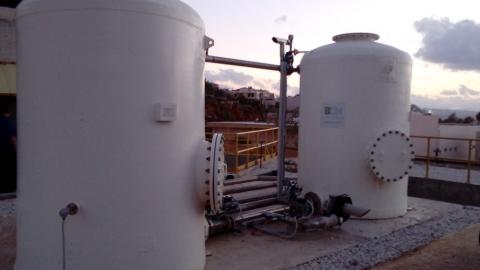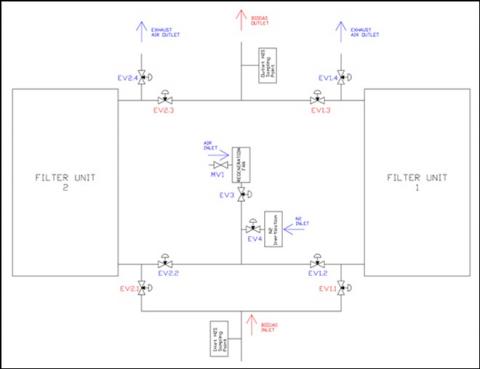Installation of a biogas desulphurisation unit at a WWTP.
Case Study: Chania WWTP (Greece)
Bioconservacion's technology was the successful bidder in the public tender launched in 2015 for the design, execution and construction of a biogas desulfurization unit at the wastewater treatment plant in Chania, Greece.
With a population of more than 100,000, Chania is the second largest municipality on the Greek island of Crete. Its wastewater treatment plant consists of primary and secondary clarifiers, two biological reactors and four anaerobic digesters to produce biogas.
This wastewater treatment plant has been designed to optimize energy integration by using the combustion of the biogas produced in a cogeneration engine (heat and electricity). The heat produced by the engine is used both to preheat the sludge in the digesters and to dry the output digestate.
These measures ensure maximum energy efficiency, but require adequate purification of the biogas to protect the internal combustion engines. Specifically, the concentration of H2S needs to be reduced from 2000 ppm to practically zero to protect the metal parts from corrosion, and thus maximize the lifetime of the engine.

The solution designed by BION was proposed in collaboration with the Greek engineering firm DIMTECH and was chosen by the management of the Chania WWTP due to its advantages over other biogas desulfurization equipment currently available, in particular:
Very high H2S adsorption capacity: 45% by weight (10 cycles).
Extremely low pressure drop through the fixed beds.
Excellent performance even in the absence of O2.
Moderate amounts of volatile organic compounds and CO2 do not affect the optimal performance of the product.
Easily regenerated up to 10 times by simply circulating ambient air through the beds.
Extremely low maintenance requirements.
The unit consists of two fixed beds mounted in parallel and configured to work with the highly efficient BION Sigma filter media in a completely autonomous and safe way.
A machine PLC integrated in the control cabinets, which handles more than 30 input/output control signals, allows fully automatic operation in all working modes (operation, inerting, regeneration and stop/bypass). Setpoint input is done from a 10" touch screen and supervision can also be done remotely, from a PC in the office or even thousands of miles away, thanks to an Internet port built into the PLC. This feature was widely used by Bioconservacion engineers during the evaluation period.

The plant started operations from 2016 and the performance evaluation tests lasted 6 months. At the end of this time, a delegation of BION technical staff performed the final commissioning and the plant was officially commissioned and successfully handed over to the customer.
With the same technology and commissioning method, excellent results can be obtained in any application requiring biogas purification (landfill biogas combustion and/or anaerobic digestion, cogeneration, biogas concentration and bio-methane injection into the grid), guaranteeing the final performance of the system.